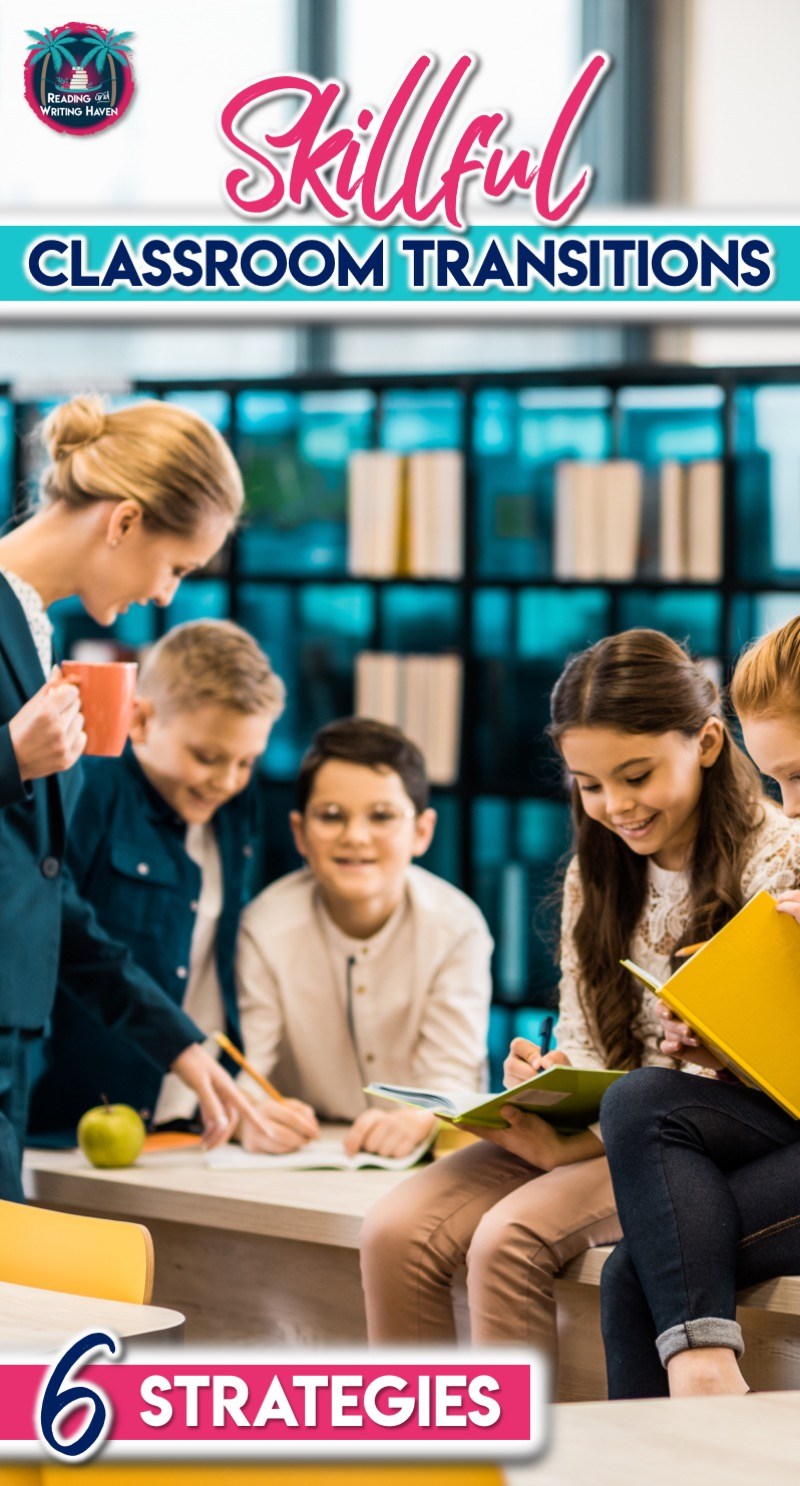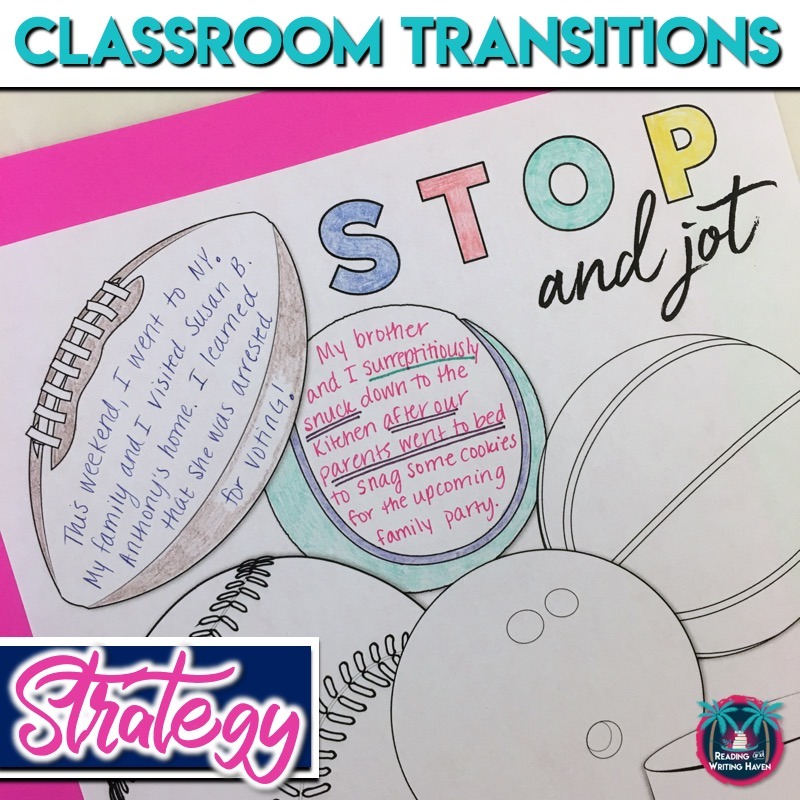Classroom Transitions: 6 Ideas and Strategies for Secondary
Lesson transitions can be frustrating when they don’t go smoothly. Move from one activity to the next efficiently using these simple tips for classroom transitions.
Imagine this: You’re teaching an engaging lesson about short stories. Students are participating in the whole-class activity. Just as you prepare to move into the next segment of the lesson, small-group instruction, your principal walks in. Of course, you can’t find the papers you need to get the activity started. Perfect timing. Students being whispering…then talking louder. Pretty soon, you have students lining up to ask questions about whether or not there will be homework and if they can use the restroom. A group in the back decides to break out their iPads to sneak in a game of Fortnite.
If you teach middle or high school students, you may be familiar with a scenario such as this. Try as we might, there are times when our classroom transitions don’t go the way we would hope. Just like everything else in education, there are best practices in lesson transitions. Let’s explore how some of these techniques can improve the efficiency of transitions during lessons.
ORGANIZATION
My classroom transitions always go smoother when I’ve organized everything I need before the period begins. Make necessary photocopies in advance. Try to put them in the same place every day so that it’s second nature to find them. Check technology in between class periods to make sure it’s still working from the last time you used it. Lay out your lesson plan notes in bulleted format somewhere that you can see them and recall what’s next on the agenda quickly.
Granted, organization is not fool-proof. There will still be times when we misplace papers, technology fails, or we are simply overwhelmed by an abundance of course preps.
ROUTINES
Like us, students are creatures of habits. Have a consistent beginning-of-class routine. Whether it’s a bell ringer or independent reading time, students will be more likely to get to work during the transition from passing period to class start if they know what is expected.
If you have some willing students, record parodies of classroom routines for future classes to evaluate. Sure, they’ll laugh and enjoy watching, but they’ll also have a memorable visual and an opportunity to evaluate what went wrong. Bonus: Have students record their own videos, completing the routine efficiently.
Also, practice! Classroom transitions are a routine, just like passing in papers and using the restroom. If your students struggle with transitioning from whole group to small group formats, practice moving desks. Do it several times in a row for a week. After each practice round, talk with students. What is going well? What needs improvement?
If your students tend to line up at the door, practice the routine for the end of class. How do you want students to transition at the end? What should it look like? What should it sound like?
SIGNALS
Perhaps part of – or separate from – your routines, you may want to consider using signals. They can help quickly grab students’ attention when things are not going as smoothly as you’d like. The basic premise behind signals is to break students’ pattern of behavior by interrupting them with an unexpected stimulus.
Think back to the example from earlier. Just as you notice your students beginning to get noisy and one stands up to approach you, you could clap twice. If trained, your students will know to clap three times in return and listen. Then, you’d have the opportunity to explain to them that you’re looking for something and give them some quick directions for what to do while they wait.
Wondering about possible signals you could use? There isn’t a “right” option. Know your students. Grade level matters. Longer signals (like counting to ten in a foreign language) don’t always keep students’ attention. Some teachers use bells of various kinds. Others use count downs. Clapping and music are popular, as are verbal queues (1-2-3, Eyes on Me; Hocus Pocus, Time to Focus) and Harry Wong’s Give Me 5.
REARRANGE
Students’ attention spans in middle school range from 10 to 12 minutes per activity, only increasing to about 15 to 20 minutes in high school. So? Chunking matters in lesson planning. However, if a class period is 50 minutes, the goal would still be to reduce the total number of transition times in order to increase learning time.
Look at your upcoming lesson plans. Are activities divided into chunks to keep students focused? Could you rearranged anything to reduce the total number of transitions?
For instance, pretend your school is 1:1 and you are planning to have students use their devices twice during one class period, at the beginning and the end. Is there any way you could put those activities back to back or eliminate the need to get devices out and put them away twice?
DIRECTIONS
We can help make transitions smoother by demanding students’ full attention and then clearly explaining what is going to happen next. Consider:
NO: Class, I want you to get out your iPads. After you log in, go to Seesaw. When you are in Seesaw….(at this point, you’ve already lost many of them because they probably pulled out their iPads and began tuning you out right away.)
YES: Class, in just a moment, we are going to be transitioning into the next part of today’s lesson. In doing so, we will need to get out our iPads. BUT! Before we do, let’s make sure everyone understands the directions. They are also written on the board behind me. It’s important that everyone is on the same page, so put on your listening ears. (After giving the directions, ask for questions. Once questions are answered, then allow students to get out their devices.)
Many times, we say, “I need your eye contact and full attention, please.” Often, students give it to us, but only for a moment. Demand attention. It’s another routine we need to practice.
FORMATIVE ASSESSMENT
Try as we might, transitions can get messy sometimes. Things come up. A student knocks at our door needing something, technology is glitchy, or, despite your best efforts at being organized, you’ve misplaced something.
For these times, consider having students keep a graphic organizer on their desk so that you can ask them to answer questions on it throughout the period. These questions can both help to fill transition time meaningfully as well as provide you with a formative assessment piece.
Students may not use the notes page every day, but the premise is simple. When you are transitioning between parts of a lesson and want to make sure students are staying focused on what they just completed or what they are about to do, give them a prompt. Have them record their answer on the graphic organizer.
You can use fun shapes on the graphic organizers* where students record their thoughts, and prompts can relate to any aspect of your subject area – or to building relationships with students. (*Sign up for my mailing list to grab a free graphic organizer and example from my resource library.)
Most importantly, follow through. After you’ve established your routines, signals, and directions, stay true to them. Just like with parenting, students quickly learn whether we mean what we say and whether we will be lax on our expectations.
Lesson transitions are an important piece of classroom management that can increase learning time and lead to a more productive and inviting classroom culture. Take some time to reflect on how you might tidy up classroom transitions so that the next time your principal stops by, you won’t even bat an eye.
Read Next:
- 5 Common Classroom Management Issues and Solutions
- 7 Strategies for Addressing Difficult Behaviors
- Tips for Building Teacher-Student Relationships
- Using Classroom Meetings to Build Community
RELATED RESOURCE:
If you’d like to get started with this graphic organizer Stop and Jot classroom transitions strategy, click on the image below. Still not sure? Try it! By signing up for my email list below, you’ll have full access to my resource library, exclusive for subscribers.


